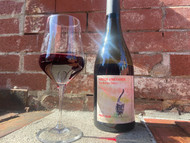The Future Comes, Tradition Beckons
Posted by Connor Kennedy on August 07 2022 7:49pm
It’s easy to draw generalizations about wine regions. There's no doubt they can be useful tools; for example, general descriptions of Pinot Noir from California contrasted with that of Burgundy in France can draw meaningful distinctions between wines coming from entirely different sides of the world. But as useful as generalizations can be in comparing and contrasting huge swaths of the world, they can sometimes obscure important distinctions within regions, which are comprised of not just a large macroclimate, but varying mesoclimates and microclimates as well. In the worst cases, generalizations can prevent people from trying a delicious wine from somewhere, perhaps because they may not jive with the general habits and tendencies of winemakers within that region. But those habits and tendencies are not set in stone, especially in relatively younger wine regions - they’re constructed by the actions of a multitude of differing winemakers, across time, who must contend with divergent conditions and their own personal eccentricities in pursuit of making good wine. Take California: how we collectively understand its wines may be different some 30 or 40 years from now, just as it was different 30 or 40 years ago. In the long, ancient history of winemaking, this span of time is miniscule. The wine I had this week, Hirsch Vineyards’ ”The Bohan-Dillon”, was a Pinot Noir from Sonoma Coast. It was quintessentially California, but to say nothing more would do this elegant wine a disservice.
David Hirsch founded Hirsch Vineyards in 1980, just north of the 19th century Russian settlement of Fort Ross. The vineyards sit on the true Sonoma Coast, an American Viticultural Area (AVA) within Sonoma County that grows some of the most coveted cooler-climate Pinot Noir and Chardonnay vines in California. The grapes from Hirsch are no exception, being sold only to other wineries until the early 2000s when Hirsch started bottling his own wine. The climate of his vineyards can be unpredictable and extreme, with diverse soil compositions that differ not just across acreage, but often from yard to yard. Hence the significance of micro- and mesoclimates, for which the nature of the land has large topographic implications. Without getting any deeper into the nerdy science, it's important to keep in mind what makes the Sonoma Coast distinct from not just the rest of Sonoma County’s AVAs, but from California more broadly. This, of course, matters most when drinking the wine. Lucky for us, Hirsch Vineyards, which fully transitioned to biodynamic viticulture by 2014, imbues that wine with a keen sense of place.

Rolling hills at Hirsch Vineyards. Source: www.hirschvineyards.com
The end result with “The Bohan-Dillon” is a seriously drinkable Pinot Noir that does not shy away from either essence or home. Sitting a pale garnet in the glass, the nose leads with a subtle oak profile, likely due to the marginal amounts of new French oak used during winemaking. Hints of violet break through as well, alongside a vibrant array of red fruits. The palate is light, with a gentle frame of oak offering silky tannins that carry through to the lengthy finish. Cherries and cranberries ride this wave, highlighted by a bright acidity coursing from the start. After a few hours of sitting open, the wine somehow gets softer and the fruit slightly more lush. Not quite as lush, however. as in much of the Pinot Noir you might find in the neighboring Russian River Valley; I suspect this wine owes its lightness and crisp acidity to its home on the cooler Sonoma Coast. The wine is dangerously good, without hiding from us its more serious depth.
This wine from Hirsch is only one of many, many wines contributing to what is understood as the “California style” of Pinot Noir. But this is an amorphous and ever-changing idea - though it vaguely means something now, there are countless winemakers learning from every vintage and from each other to bring their wine in closer communion to the earth (and our mouths). For some, this means spurning heavy use of new oak, something that many California winemakers have been disposed to doing in recent decades. There is less barrel aging for “The Bohan Dillon” than for Hirsch’s other Pinot Noirs, which is likely why the wine resonated with me so deeply. It’s a gorgeous balance between being unabashedly Californian while pursuing something all its own. Change and tradition are forever in tension, but that’s often an opportunity for creativity. In our era of climate change, vintners the world over are having change thrust upon them whether they like it or not. Having some degree of flexibility and an eye towards both the past and the future will serve them well.

